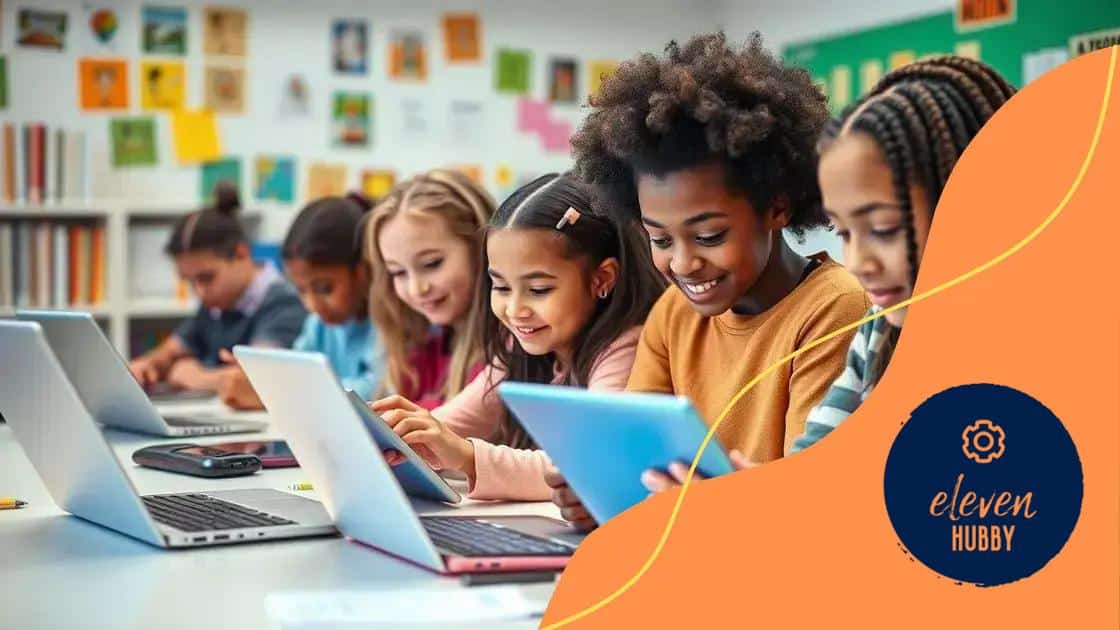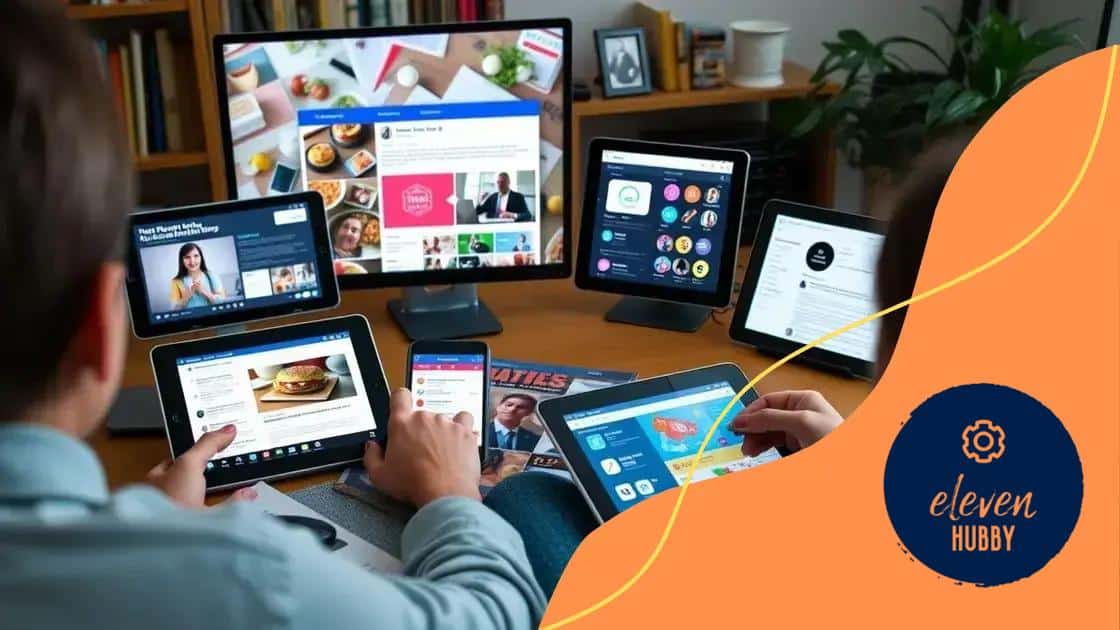The role of social media in modern education systems

The role of social media in modern education systems enhances student engagement, fosters collaboration, and provides access to diverse resources while also introducing challenges like distractions and cyberbullying.
The role of social media in modern education systems is more significant than ever. With platforms like Facebook and Instagram, learning extends beyond traditional classrooms. Wonder how this impacts students and teachers? Let’s dive in.
Transforming classroom interaction
Social media is transforming classroom interaction in exciting ways. With tools like Twitter and Instagram, teachers and students engage like never before.
This shift encourages a more collaborative environment, where students can share ideas and feedback instantly. As a result, traditional barriers between teachers and students are breaking down, leading to more open communication.
Benefits of using social media in classrooms
There are several clear benefits to utilizing social media in educational settings:
- Instant access to resources and information
- Enhanced collaboration on group projects
- Real-time feedback from peers and instructors
- Increased student engagement and motivation
By creating dedicated class pages or groups on platforms like Facebook, instructors can easily share announcements, resources, and facilitate discussions. This not only keeps everyone in the loop but also encourages students to participate actively.
Engaging with diverse learning styles
Social media also accommodates various learning styles. For visual learners, sharing videos or infographics can make complex topics clearer. Auditory learners might benefit from podcasts or live discussions hosted on these platforms.
Moreover, students who may be shy in a traditional classroom setting often find their voices in online discussions. This enables them to express their thoughts in a comfortable environment. Consequently, it fosters a sense of community and belonging among students.
As we continue to embrace these modern tools, it’s essential to stay aware of the potential challenges. However, the positive impact of social media on classroom interaction is becoming increasingly evident.
Building community through online platforms
Building community through online platforms is vital for enhancing student relationships and engagement. Social media allows students to connect outside the classroom, forming bonds that extend learning.
These platforms create spaces where learners can share experiences, ask questions, and support each other. This sense of belonging often leads to improved participation in class and a greater desire to learn.
Advantages of online communities
Online communities provide numerous benefits:
- Access to diverse perspectives from peers
- Opportunities for collaboration on projects
- Support networks for academic challenges
- Development of interpersonal skills
For example, students might work together on a project using group chats or forums. This real-time interaction fosters collaboration and innovation. Sharing resources and ideas in these online spaces can enrich the educational experience.
Fostering inclusion and belonging
Online platforms also play a crucial role in fostering a sense of inclusion. Students from different backgrounds can share their stories, which promotes a deeper understanding among peers. This diverse exchange not only strengthens community ties but also builds respect and empathy.
Furthermore, online groups can make it easier for introverted students to find their voices. As they engage with others, they become more confident in expressing their thoughts. Building these communities helps all students feel valued and recognized for their contributions.
Education is about teamwork as much as individual effort. By leveraging online platforms, students can cultivate a vibrant community that enhances both their personal and academic growth.
Resources for effective learning

Resources for effective learning are essential in today’s educational landscape. Social media platforms offer a variety of tools that can enhance student engagement and understanding.
Accessing helpful resources online allows students to learn at their own pace. With just a few clicks, learners find articles, videos, and tutorials tailored to their needs, making the learning process more effective and enjoyable.
Types of resources available
Here are some important types of resources students can utilize:
- Tutorial videos that explain complex topics easily
- Educational infographics for quick reference
- Interactive quizzes to reinforce knowledge
- Discussion forums for peer support
These resources help break down challenging subjects into digestible pieces. For instance, a student struggling with math can watch a video lesson on a particular topic. This targeted support fosters a better understanding and boosts confidence.
Leveraging social media for learning
Social media can also be a powerful tool for learning. Platforms such as YouTube and Instagram are rich with content created by educators and experts. Students can follow channels or accounts that align with their subjects of interest and discover new methods of studying.
Moreover, many educators share innovative ideas and resources through Twitter and group pages on Facebook. Following these sources can provide ongoing professional development for both students and teachers, ensuring they stay updated on effective learning strategies.
By incorporating these diverse resources into their studies, students can tailor their learning experiences to match their styles. With the right tools, effective learning becomes an achievable goal.
Challenges of social media in education
The challenges of social media in education can impact the learning experience significantly. While these platforms offer numerous benefits, they also present obstacles that educators and students must navigate.
One major concern is the distraction factor. With notifications and messages constantly popping up, students may find it hard to stay focused on their studies. This can hinder their ability to absorb information effectively.
Common challenges faced
Some other challenges include:
- Cyberbullying, which can affect student mental health
- Inaccurate information being shared, leading to confusion
- Privacy issues, regarding personal information
- Digital divide where some students lack access to technology
These issues highlight the need for schools to develop clear guidelines on social media usage. Educators must teach students how to navigate these platforms safely and responsibly, ensuring they understand both the benefits and the risks.
Setting boundaries and guidelines
By establishing boundaries, schools can help minimize distractions during learning. For instance, restricting social media access during class time can help maintain student attention. Additionally, creating a digital citizenship curriculum can guide students in using social media wisely.
It is also essential for teachers to monitor student interactions online. This enables them to recognize issues such as cyberbullying early on and address them effectively. Encouraging open communication about these challenges can foster a supportive environment where students feel safe discussing their online experiences.
Despite the challenges of social media in education, with the right support and strategies, students can benefit from these platforms while minimizing negative impacts.
Future trends in educational social media
Future trends in educational social media are shaping how learning happens in classrooms. As technology evolves, these platforms will play an even more significant role in enhancing student engagement.
One trend is the growing use of virtual reality (VR) to create immersive learning experiences. With VR, students can explore historical sites or conduct virtual science experiments, making learning much more interactive.
Increased personalization
Another anticipated trend is the move towards personalized learning. Social media platforms can analyze user data to tailor educational content specifically for each student. This means learners receive resources and assignments that match their interests and skill levels.
- Adaptive learning systems that adjust based on student performance
- Customized learning pathways for individual needs
- Real-time feedback to enhance understanding
- Content curated based on preferences and past interactions
This increased personalization helps keep students motivated and engaged. It allows them to take ownership of their learning journey, leading to better outcomes.
The role of influencers and creators
Additionally, the role of content creators and influencers in education is expected to rise. Educators can collaborate with influencers to share knowledge and inspire students on platforms like YouTube and Instagram. This can make learning more relatable and fun for young learners.
Moreover, with the rise of micro-learning, short, focused lessons delivered via social media will become popular. This approach allows students to engage with content in bite-sized pieces, making learning more manageable and less overwhelming.
As we look to the future, it’s clear that educational social media will continue to evolve, providing innovative tools and methods that enhance the learning experience for students everywhere.
FAQ – Frequently Asked Questions about the Role of Social Media in Modern Education
How can social media enhance student engagement?
Social media enables students to connect with peers and teachers, fostering collaboration and making learning more interactive.
What are some common challenges of using social media in education?
Distractions, cyberbullying, and the spread of inaccurate information are significant challenges that educators must address.
How can schools create safe social media environments?
Establishing clear guidelines, educating students on responsible use, and monitoring interactions can help maintain a safe online space.
What future trends should we expect in educational social media?
Increased personalization, the use of virtual reality, and partnerships with content creators will shape the future of learning through social media.






